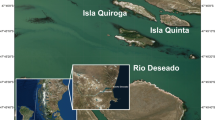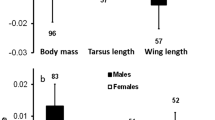Abstract
Extra-pair paternity is common in socially monogamous passerines; however, despite considerable research attention, consistent differences in fitness between within-pair offspring (WPO) and extra-pair offspring (EPO) have not been demonstrated. Recent evidence indicates that differences between maternal half-siblings may depend on environmental conditions, but it is unclear whether the influence of paternal genetic contribution should be most apparent under comparatively poor or favourable conditions. We compared phenotypic characteristics of WPO and EPO in 30 mixed-paternity broods of the tree swallow (Tachycineta bicolor) in relation to experimentally increased nest temperature (n = 13 heated nests; 17 control nests) and natural abundance of haematophagous parasites (Protocalliphora spp.). This allowed us to test the hypothesis that genetic benefits of extra-pair mating are environment dependent. EPO grew their ninth primary feathers faster than WPO regardless of nest temperature or parasite load and had significantly longer ninth primary feathers at fledging when parasite abundance was low, and when they were positioned early in the hatching sequence relative to WPO. In contrast, WPO under similar conditions did not differ from EPO in any phenotypic trait measured. These results indicate that the fitness benefits of extra-pair mating are likely to be context dependent, and that genetic effects on some phenotypic traits may be more apparent when conditions are relatively favourable.

Similar content being viewed by others
References
Ashton JC, Armstrong DP (2002) Facultative prioritization of wing growth in the welcome swallow Hirundo neoxena. Ibis 144:470–477
Barber CA, Robertson RJ, Boag PT (1996) The high frequency of extra-pair paternity in tree swallows is not an artifact of nestboxes. Behav Ecol Sociobiol 38:425–430
Birkhead T, Schwabl H, Burke T (2000) Testosterone and maternal effects—integrating mechanisms and function. Trends Ecol Evol 15:86–87
Bize P, Roulin A, Bersier L-F, Pfluger D, Richner H (2003) Parasitism and developmental plasticity in alpine swift nestlings. J Anim Ecol 72:633–639
Bowlin MS, Winkler DW (2004) Natural variation in flight performance is related to timing of breeding in tree swallows (Tachycineta bicolor) in New York. Auk 121:345–353
Brown CR, Brown MB (1998) Intense natural selection on body size and wing and tail asymmetry in cliff swallows during severe weather. Evolution 52:1461–1475
Clotfelter ED, Whittingham LA, Dunn PO (2000) Laying order, hatching synchrony, and nestling body mass in tree swallows (Tachycineta bicolor). J Avian Biol 31:329–334
Conrad KF, Johnston PV, Crossman C, Kempenaers B, Robertson RJ, Wheelwright NT, Boag PT (2001) High levels of extra-pair paternity in an isolated low-density, island population of tree swallows (Tachycineta bicolor). Mol Ecol 10:1301–1308
Crossman CC (1996) Single locus DNA profiling in the tree swallow Tachycineta bicolor: a comparison of methods. MSc thesis, Queen’s University, Canada
Cunningham EJA, Russell AF (2000) Egg investment is influenced by male attractiveness in the mallard. Nature 404:74–77
Dawson RD, Lawrie CC, O’Brien EL (2005a) The importance of microclimate variation in determining size, growth and survival of avian offspring: experimental evidence from a cavity nesting passerine. Oecologia 144:499–507
Dawson RD, Hillen KK, Whitworth TL (2005b) Effects of experimental variation in temperature on larval densities of parasitic Protocalliphora (Diptera: Calliphoridae) in nests of tree swallows (Passeriformes: Hirundinidae). Environ Entomol 34:563–568
Festa-Bianchet M, Coltman DW, Turelli L, Jorgenson JT (2004) Relative allocation to horn and body growth in bighorn rams varies with resource availability. Behav Ecol 15:305–312
Gebhardt-Henrich SG, Richner H (1998) Causes of growth variation and its consequences for fitness. In: Starck JM, Ricklefs RE (eds) Avian growth and development. Oxford University Press, Oxford, pp 324–339
Gil D, Graves J, Hazon N, Wells A (1999) Male attractiveness and differential testosterone investment in zebra finch eggs. Science 286:126–128
Griffith SC, Owens IPF, Thuman KA (2002) Extra pair paternity in birds: a review of interspecific variation and adaptive function. Mol Ecol 11:2195–2212
Hoffman AA, Merilä J (1999) Heritable variation and evolution under favourable and unfavourable conditions. Trends Ecol Evol 14:96–101
Hurtrez-Boussès S, de Garine-Wichatitsky M, Perret P, Blondel J, Renaud F (1997) Variations in prevalence and intensity of blow fly infestations in an insular Mediterranean population of blue tits. Can J Zool 77:337–341
Jamieson A (1994) The effectiveness of using codominant polymorphic allelic series for (1) checking pedigrees and (2) distinguishing full-sib pair members. Anim Genet 25:19–23
Jia F-Y, Greenfield MD, Colins RD (2000) Genetic variance of sexually selected traits in waxmoths: maintenance by genotype × environment interaction. Evolution 54:953–967
Johnson A, Andersen V, Sundling C, Lifjeld JT (2000) Female bluethroats enhance offspring immunocompetence through extra-pair copulations. Nature 406:296–299
Kempenaers B, Verheyen GR, Dhondt AA (1997) Extrapair paternity in the blue tit (Parus caeruleus): female choice, male characteristics, and offspring performance. Behav Ecol 8:481–492
Kleven O, Lifjeld JT (2004) Extrapair paternity and offspring immunocompetence in the reed bunting, Emberiza schoeniclus. Anim Behav 68:283–289
Leonard ML, Horn AG (1996) Provisioning rules in tree swallows. Behav Ecol Sociobiol 38:341–347
Lubjuhn T, Stronbach S, Brün J, Gerken T, Epplen JT (1999) Extra-pair paternity in great tits (Parus major): a long term study. Behaviour 136:1157–1172
Malausa T, Guillemaud T, Lapchin L (2005) Combining genetic variation and phenotypic plasticity in tradeoff modelling. Oikos 110:330–338
Marshall TC, Slate J, Kruuk LEB, Pemberton JM (1998) Statistical confidence for likelihood-based paternity inference in natural populations. Mol Ecol 7:639–655
Martins TLF (1997) Fledging in the common swift, Apus apus: weight-watching with a difference. Anim Behav 54:99–108
McCarty JP (2001) Variation in growth of nestling tree swallows across multiple temporal and spatial scales. Auk 118:176–190
McCarty JP (2002) The number of visits to the nest by parents is an accurate measure of food delivered to nestlings in tree swallows. J Field Ornithol 73:9–14
Merilä J (1997) Expression of genetic variation in body size of the collared flycatcher under different environmental conditions. Evolution 51:526–536
Merino S, Potti J (1996) Weather dependent effects of nest ectoparasites on their bird hosts. Ecography 19:107–113
Michaud T, Leonard M (2000) The role of development, parental behavior, and nestmate competition in fledging of nestling tree swallows. Auk 117:996–1002
Norušis MJ (2000) SPSS 11.0 Guide to data analysis. Prentice Hall, Upper Saddle River
O’Brien EL, Morrison BL, Johnson LS (2001) Assessing the effects of haematophagous ectoparasites on the health of nestling birds: haematocrit vs haemoglobin levels in house wrens parasitized by blow fly larvae. J Avian Biol 32:73–76
Parker TH (2003) Genetic benefits of mate choice separated from differential maternal investment in red junglefowl (Gallus gallus). Evolution 57:2157–2165
Petrie M, Kempenaers B (1998) Extra-pair paternity in birds: explaining variation between species and populations. Trends Ecol Evol 13:52–58
Primmer CR, Møller AP, Ellegren H (1995) Resolving genetic relationships with microsatellite markers: a parentage testing system for the swallow Hirundo rustica. Mol Ecol 4:493–498
Primmer CR, Møller AP, Ellegren H (1996) New microsatellites from the pied flycatcher Ficedula hypoleuca and the swallow Hirundo rustica genomes. Hereditas 124:281–283
Qvarnström A (1999) Genotype-by-environment interactions in the determination of the size of a secondary sexual character in the collared flycatcher (Ficedula albicollis). Evolution 53:1564–1572
Qvarnström A (2001) Context-dependent genetic benefits from mate choice. Trends Ecol Evol 16:5–7
Robertson RJ, Stutchbury BJ, Cohen RR (1992) Tree swallow (Tachycineta bicolor). In: Poole A, Stettenheim P, Gill F (eds) The birds of North America, no. 11. The Academy of Natural Sciences, Philadelphia, PA
Rogers CA, Robertson RJ, Stutchbury BJ (1991) Patterns and effects of parasitism by Protocalliphora sialia on tree swallow nestlings. In: Loye JE, Zuk M (eds) Bird-parasite interactions: ecology, evolution and behaviour. Oxford University Press, Oxford, pp 123–139
Ryan PG (2001) Morphological heritability in a hybrid bunting complex: Nesospiza at Inaccessible Island. Condor 103:429–438
Saino N, Incagli M, Martinelli R, Ambrosini R, Møller AP (2001) Immunity, growth and begging behavior of nestling barn swallows Hirundo rustica in relation to hatching order. J Avian Biol 32:263–270
Schmoll T, Dietrich V, Winkell W, Epplen JT, Schurr F, Lubjuhn T (2005) Paternal genetic effects on offspring fitness are context dependent within the extrapair mating system of a socially monogamous passerine. Evolution 59:645–657
Seutin G, White BN, Boag PT (1991) Preservation of avian blood and tissue samples for DNA analyses. Can J Zool 69:82–90
Sheldon BC (2000) Differential allocation: tests, mechanisms and implications. Trends Ecol Evol 15:397–402
Sheldon BC, Merilä J, Qvarnström A, Gustafsson L, Ellegren H (1997) Paternal genetic contribution to offspring condition predicted by size of male secondary sexual character. Proc R Soc Lond B 264:297–302
Sheldon BC, Arponen H, Laurila A, Crochet P-A, Merilä J (2003) Sire coloration influences offspring survival under predation risk in the moorfrog. J Evol Biol 16:1288–1295
Smits JE, Bortolotti GR, Tella JL (1999) Simplifying the phytohaemagglutinin skin-testing technique in studies of avian immunocompetence. Funct Ecol 13:567–572
Tripet F, Richner H (1997) Host responses to ectoparasites: food compensation by parent blue tits. Oikos 78:557–561
Welch AM (2003) Genetic benefits of a female mating preference in grey tree frogs are context-dependent. Evolution 57:883–893
Whittingham LA, Dunn PO (2001) Survival of extrapair and within-pair young in tree swallows. Behav Ecol 12:496–500
Whittingham LA, Dunn PO, Clotfelter ED (2003) Parental allocation of food to nestling tree swallows: the influence of nestling behaviour, sex and paternity. Anim Behav 65:1203–1210
Acknowledgements
We thank Stephen Pruett-Jones and two anonymous reviewers for comments on a previous version of the manuscript. Anita Castle and Greg Sanders granted property access, and Dan Baxter, Pierre-Paul Bitton and Ben Schonewille provided assistance in the field. We are grateful to Brent Murray for providing access to lab space and equipment, as well as the UNBC molecular genetics lab and Mary Stapleton for advice and discussions concerning genetic analyses. Funding was provided by a Discovery Grant to Russell D. Dawson from the Natural Sciences and Engineering Research Council of Canada. Additional funding was provided by the Canada Foundation for Innovation and British Columbia Knowledge Development Fund. Our research protocols were approved by the Animal Care and Use Committee of UNBC.
Author information
Authors and Affiliations
Corresponding author
Additional information
Communicated by S. Pruett-Jones
Rights and permissions
About this article
Cite this article
O’Brien, E.L., Dawson, R.D. Context-dependent genetic benefits of extra-pair mate choice in a socially monogamous passerine. Behav Ecol Sociobiol 61, 775–782 (2007). https://doi.org/10.1007/s00265-006-0308-8
Received:
Revised:
Accepted:
Published:
Issue Date:
DOI: https://doi.org/10.1007/s00265-006-0308-8




